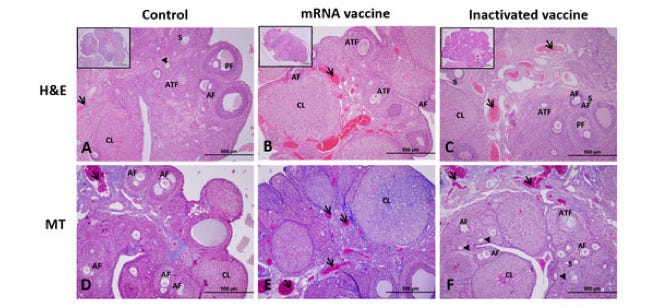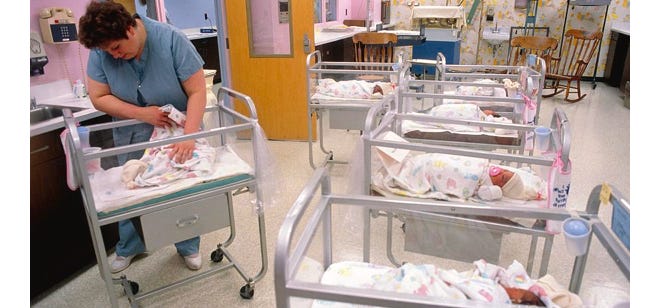Appropos for Mother’s Day, a quiet March jab study made the rounds this week. The study, published in the Journal Vaccines, was blandly titled, “
Impact of mRNA and Inactivated COVID-19 Vaccines on Ovarian Reserve.” Scoffers complained it was “only” a rat study, but it was another iron nail in mRNA’s coffin.

The truth is: it was more
terrible news for the jabs. The slow trickle of truth emerging in the scientific journals is reaching a cacophonous crescendo. This newest study confirmed the worst suspicions of many folks who’ve long suspected a link between plunging worldwide fertility rates and the simultaneous worldwide deployment of the mRNA vaccines.
For heterodox experts who’ve long warned, “Something this widespread with this kind of novel platform could have unintended reproductive effects,” this study landed like a flashing red light. It doesn’t settle the debate— but it clearly shifts the burden of proof. The dismissive “safe and effective” mantra now looks a lot less like a conclusion and more like a placeholder awaiting serious investigation.
This new
peer-reviewed animal study raises questions that demand
answers about the human effects of covid vaccines —especially the mRNA types— specifically on
female fertility. The researchers gave rats human-equivalent doses of either Pfizer’s mRNA vaccine or Sinovac’s inactivated spike vaccine. A few weeks later, they checked the furry little volunteers’ ovarian tissues.
What they found was extremely sinister. Both vaccines disrupted normal ovarian function, both reducing the number of healthy egg follicles and increasing the number of dying or damaged ones. Hormone levels tied to fertility, particularly “anti-Müllerian hormone” (AMH), dropped significantly— and most sharply in the mRNA group. In plain English: the rats had fewer eggs and significant signs of reproductive stress.

‘Follicles’ are the functional core of a woman’s reproductive system— they’re tiny fluid-filled sacs in the ovaries that each contain an immature egg. Every menstrual cycle, a woman’s body selects a few of these follicles to mature. Ideally, one of them releases a viable egg during ovulation. But here’s the catch: women are born with a
fixed number of follicles, and once they’re gone,
that’s it. No replacements; you get what you get. This finite supply is called the
ovarian reserve, and it determines both a woman’s reproductive lifespan and her fertility potential.
While rats aren’t humans, the biological mechanisms are close enough to be terrifying. Rats have ovarian follicles and reproductive hormones remarkably similar to humans, which is why they’re widely used in reproductive research. While there are some differences in timing and hormonal cycles, the fundamental biology is the same.
Not only did the study show damage to the follicles themselves, but it evidenced that vaccination —especially with mRNA— disrupts
hormone signaling related to fertility, by reducing the AMH hormone that indicates how many viable eggs remain. That single finding could plausibly explain the widespread reports of disrupted menstrual cycles following covid vaccination.
The study didn’t look at direct ‘fertility outcomes’ (actually getting pregnant), but it showed clear changes to the structures and hormones that make fertility possible in the first place. The findings don’t prove the vaccines harm
human fertility— but they demolished the idea that there’s
no evidence of harm.
There is now conclusive
evidence of harm, even if not conclusive
proof. And the evidence is strong, consistent, biologically credible, and peer-reviewed.
This study suggests the FDA skipped a critical step: before mass deployment, this kind of reproductive impact
should have been studied in depth. Instead, it’s only being belatedly noticed by independent researchers after the needled horse is out of the barn. More research in human women is urgently needed— not to create panic, but to
finally take the question seriously.

Global fertility rates have been declining for years, blamed largely on socioeconomic trends like delayed childbearing, urbanization, and falling marriage rates. But what’s grabbed everyone’s attention was the sharp acceleration in the decline during 2021–2023— a period that coincides
almost exactly with the worldwide rollout of mRNA covid vaccines.
In some countries, birth rates dropped 7%–15% year-over-year, far beyond typical demographic variation, and without any clear alternative explanation.
For example, here’s a March, 2024, headline
from The Lancet:

This rat study didn’t
prove causation, but it showed a plausible mechanism: vaccination-induced follicular loss, reproductive hormone disruption, and increased ovarian apoptosis (cell death). If a similar effect occurred in women —even temporarily— it could reduce fecundity (the ability to conceive) during at least that window.
And since conception is already a narrow, monthly biological opportunity, small disruptions across large populations could have macro-level fertility effects— especially in low-replacement societies already teetering below 2.1 births per woman. A global birth rate collapse would be a slow-motion extinction event. It would creep up until some awful tipping point was reached and then it would quickly be
game over.

The study resolved a critical question:
is this possible? The next question
demanding an answer now is,
why aren’t public health authorities urgently conducting large-scale reproductive follow-up studies on women of childbearing age, using easily detectable markers like AMH and antral follicle counts?
The reluctance to blame jab makers and government jab pushers is a poor reason to delay urgently needed research. It’s not just “water under the bridge,” or as Hillary might ask, “at this point, what does it matter?” The point is that, if we can identify the
cause, we can start working on the
cure.

The longer we tiptoe around the possibility that mass vaccination campaigns might have played a role in plummeting fertility, the longer we delay
both accountability
and solutions. Because if the shots
are indeed part of the problem, then understanding how they affect reproduction is the first step to developing interventions, reversals, and informed screening. This isn’t (only) about blame; it’s about basic public health triage: find the bleeding artery and clamp it, even if it clobbers the credibility of a few cockroach-like public health experts.
Our public health experts are obviously corrupt, sold-out, and useless. Hopefully, President Trump’s new HHS will notice this study and fund more research
stat.
 ️ MEMENTO MORI ☙ Tuesday, April 22, 2025 ☙ C&C NEWS
️ MEMENTO MORI ☙ Tuesday, April 22, 2025 ☙ C&C NEWS 







